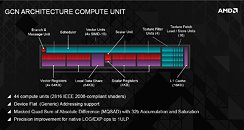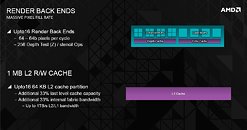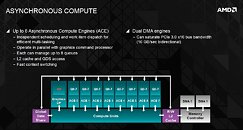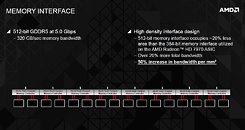- Joined
- Oct 9, 2007
- Messages
- 47,890 (7.38/day)
- Location
- Dublin, Ireland
| System Name | RBMK-1000 |
|---|---|
| Processor | AMD Ryzen 7 5700G |
| Motherboard | Gigabyte B550 AORUS Elite V2 |
| Cooling | DeepCool Gammax L240 V2 |
| Memory | 2x 16GB DDR4-3200 |
| Video Card(s) | Galax RTX 4070 Ti EX |
| Storage | Samsung 990 1TB |
| Display(s) | BenQ 1440p 60 Hz 27-inch |
| Case | Corsair Carbide 100R |
| Audio Device(s) | ASUS SupremeFX S1220A |
| Power Supply | Cooler Master MWE Gold 650W |
| Mouse | ASUS ROG Strix Impact |
| Keyboard | Gamdias Hermes E2 |
| Software | Windows 11 Pro |
An alleged company slide detailing the architecture of AMD's upcoming "Hawaii" GPU was leaked to the web, revealing a monstrous combination of components. The GPU maintains the same component hierarchy as "Tahiti." The most distinguishing feature here is that whereas "Tahiti" features two shader engines, "Hawaii" features four. What it translates to, is double the geometry processing power, four independent geometry processors with a tessellation unit each, and double the number of ROPs, at 64. Each shader unit features 11 compute units (CU), the number-crunching machinery of the GPU. Each CU holds 4 TMUs (texture memory units), and 64 stream processors.
The four shader engines of "Hawaii" are tied to a unified command processing structure, a 1 megabyte L2 cache, a 512-bit wide GDDR5 memory interfaces, and the ancillaries, that include the PCI-Express 3.0 x16 bus interface, six display controllers (six TMDS links in all), CrossFireX XDMA, and multimedia accelerators that include UVD (accelerates high-def video), VCE (video codec engine, accelerates multimedia codecs), and the new TrueAudio hardware DSP.





View at TechPowerUp Main Site
The four shader engines of "Hawaii" are tied to a unified command processing structure, a 1 megabyte L2 cache, a 512-bit wide GDDR5 memory interfaces, and the ancillaries, that include the PCI-Express 3.0 x16 bus interface, six display controllers (six TMDS links in all), CrossFireX XDMA, and multimedia accelerators that include UVD (accelerates high-def video), VCE (video codec engine, accelerates multimedia codecs), and the new TrueAudio hardware DSP.





View at TechPowerUp Main Site













